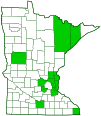Skirted Stinkhorn
(Phallus duplicatus)
Conservation • Description • Habitat • Ecology • Distribution • Taxonomy
Conservation Status |
|
|||||||
| IUCN Red List | not listed |
|||||||
| NatureServe | not listed |
|||||||
| Minnesota | not listed |
|||||||
Description |
||
Skirted Stinkhorn is an easily recognized stinkhorn mushroom. It is the only skirted stinkhorn in North America north of Mexico. It occurs in the United States from Maine to South Carolina, west to Minnesota and Tennessee, in Canada from Nova Scotia west to southern Ontario, and in Great Britain. There are also scattered reports from Europe, Asia, South Africa, Central America, northern South America, and the Pacific Northwest of North America. The reports from Brazil and South Africa are reliable. Those from Europe are suspected of being misidentifications of Phallus indusiatus. Skirted Stinkhorn is found in summer and fall, alone or in small groups but not clustered (gregarious), in hardwood forests, landscaped areas, gardens, flower beds, and wood chips. It grows on the ground and obtains its nutrients from decayed wood (saprobic). When the fruiting body first appears, it is whitish to purplish, egg-shaped or nearly round, 1¼″ to 3″ (3 to 8 cm) long, and ¾″ to 1½″ (2 to 4 cm) wide. The “egg” is attached to the substrate by thread-like, branched, white to purplish strands of mycelium (rhizomorphs). Inside the egg there is a brownish gelatinous layer, a dark olive-green spore mass, and all of the fully formed parts of the stinkhorn. As the stinkhorn expands the gelatinous layer mixes with the spore mass producing a slime. Pressure from the expanding stinkhorn eventually causes the egg to rupture. In one or two days it produces a distinctly phallic structure with a stalk and thimble-like head. The rapid expansion is possible because all of the parts are fully formed and compressed inside the egg, and because the individual cells elongate, rather than new cells being produced. A net-like skirt (indusium) grows from the bottom of the cap. The mature stinkhorn is cylinder-shaped and 2″ to 6¾″ (5 to 17 cm) long. The head is broadly cone-shaped and 1¼″ to 2″ (3 to 5 cm) high. At first it appears smooth due to a thick covering of shiny, dark olive-green, spore-bearing slime (gleba). The slime has a strong, putrid odor, repulsive to humans but irresistible to flies, which feed on it, lay their eggs in it, and transfer spores when they fly to other stinkhorns. As it ages, the head develops a circular opening at the top that is surrounded by a white lip. As the gleba is carried off by flies and/or washed off by rain it reveals a whitish, deeply pitted and ridged, net-like (reticulate) surface. The stalk is hollow, dry, white or whitish, 3″ to 5″ (8 to 13 cm) long, and ¾″ to 1¼″ (2 to 3 cm) thick. The surface is minutely sponge-like with 1 to 2 pit-like depressions per millimeter. At the base of the stalk there is a whitish to purplish, ¾″ to 2″ (2 to 5 cm) high cup (volva), the persistent remains of the egg. The indusium hangs from the bottom rim of the head and grows slowly. It is white and has relatively small holes. At maturity it is 1¼″ to 2⅜″ (3 to 6 cm) long and flares slightly away from the stalk. |
||
Similar Species |
||
Habitat and Hosts |
||
|
||
Ecology |
||
Season |
||
Summer and fall |
||
Distribution |
||||
|
Sources |
|||
| 12/6/2022 | ||||
Occurrence |
||||
|
||||
Taxonomy |
|||
| Kingdom | Fungi (Fungi) | ||
| Subkingdom | Dikarya | ||
| Phylum | Basidiomycota (club fungi) | ||
| Subphylum | Agaricomycotina (jelly fungi, yeasts, and mushrooms) | ||
| Class | Agaricomycetes (mushrooms, bracket fungi, puffballs, and allies) | ||
| Subclass | Phallomycetidae | ||
| Order | Phallales (stinkhorns and allies) | ||
| Family | Phallaceae (stinkhorns) | ||
| Genus | Phallus | ||
Index Fungorum and MycoBank both list Phallus duplicatus as a synonym of Phallus indusiatus. All other sources list Phallus duplicatus as a legitimate species with a shorter indusium and larger spores, and Phallus indusiatus having a range in the Americas extending north only as far as Mexico. This may represent an error in Index Fungorum introduced in 2019 then replicated in MycoBank. |
|||
Synonyms |
|||
Dictyophora duplicata Hymenophallus duplicatus |
|||
Common Names |
|||
Netted Stinkhorn Skirted Stinkhorn Wood Witch |
|||
Glossary
Gleba
The inner spore-bearing mass of puffballs, earthstars, and stinkhorns. The term is also used to refer to the spore-bearing slime covering the head of a stinkhorn.
Indusium
Undergarment. In ferns: A veil covering the cluster (sorus) of spore-producing structures (sporangia). In fungi: A skirt-like structure hanging from the cap (receptacle) of a stinkhorn.
Mycelium
The vegetative part of a fungus; consisting of a mass of branching, thread-like hyphae, through which a fungus absorbs nutrients from its environment; and excluding the fruiting, reproductive structure.
Saprobic
A term often used for saprotrophic fungi. Referring to fungi that obtain their nutrients from decayed organic matter.
Volva
Also called cup. A cup-like covering at the base of a mushroom stem, sometimes buried. In Amanita, Volvariella, and some other mushrooms, it is the remnants of the universal veil ruptured by the mushroom pushing through. In Phallales it is the remnants of the ruptured peridium.
Visitor Photos |
|||||
Share your photo of this fungus. |
|||||
| This button not working for you? Simply email us at info@MinnesotaSeasons.com. Attach one or more photos and, if you like, a caption. |
|||||
Greg Watson |
|||||
Netted Stinkhorn This is the “egg” taken the day before, 9/15/2022 at 9 am. |
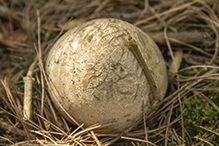 |
||||
The next day, 9/16/2022. It had erupted from the egg sometime overnight and before 7 am. |
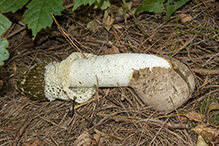 |
||||
Closeup of the cap and indusium. |
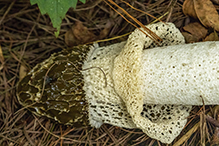 |
||||
Different angle with flies attracted to the stinkhorn. |
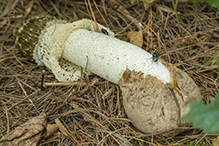 |
||||
Closeup of the cap showing the foul smelling gleba. |
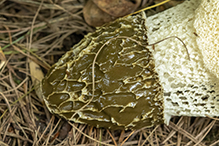 |
||||
A bald faced wasp attracted to the stinkhorn. |
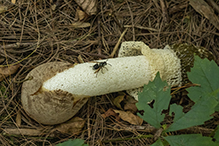 |
||||
MinnesotaSeasons.com Photos |
|||||
|
|||||

Slideshows |
||

Visitor Videos |
|||
Share your video of this fungus. |
|||
| This button not working for you? Simply email us at info@MinnesotaSeasons.com. Attach a video, a YouTube link, or a cloud storage link. |
|||
Other Videos |
|||
| Life on the Veiled Stinkhorn, Phallus duplicatus Bill Sheehan |
|||
About
Jun 3, 2018 Flies and beetles love this fungus. |
|||
| Finding the Netted Stinkhorn (Phallus duplicatus) in Vermont Fascinated By Fungi |
|||
About
Sep 23, 2021 Oh man, what stinks?!? 🤢🤢🤢 It’s the #NettedStinkHorn #WoodWitch or #Phalluseuplicatus. This rude looking mushroom (also known as #TheFlasher) is a Stink Horn type mushroom. They are saprobic (decay) mushroom that grows on rotting organic matter on the forest floor. They are a gasteroid mushroom where the spores develop internally. The spores of stinkhorns are embedded in a gleba, or sticky mass of good that stinks to high heaven when mature. The stink gleba covers the tip of this mushroom, attracting flies with the stench of rotting flesh. These flies in turn walk around in the gleba and help to disperse the spores. This species is known for its distinctive netting or skirt that emerges in maturity. I am thoroughly deterred by the smell of these, but the white part inside is edible when still in the egg phase. The jelly part is quite tough and would be very challenging to eat. The overpowering odor of the mature fruiting body is due to fungal derived secondary metabolites, with the most significant contributions to the stink coming from Dimethyl oligosulfides (smelly sulfur compounds). Frankly, I felt pretty ill while out hunting for these but it was still super exciting to find these incredible mushrooms. Many thanks to @reggie_serafin for sharing his spots with me. |
|||
| Time-lapse Emergence of the Stinkhorn Fungus, Phallus duplicatus Eric Ozkan |
|||
About
Nov 8, 2021 Filmed the emergence of this stinkhorn fungus over a period of about 48 hours. |
|||

Visitor Sightings |
|||||
Report a sighting of this fungus. |
|||||
| This button not working for you? Simply email us at info@MinnesotaSeasons.com. Be sure to include a location. |
|||||
| Greg Watson 9/16/2022 |
Location: Vetsch Park in La Crescent The next day, 9/16/2022. It had erupted from the egg sometime overnight and before 7 am. |
||||
| Greg Watson 9/15/2022 |
Location: Vetsch Park in La Crescent This is the “egg” taken the day before, 9/15/2022 at 9 am. |
||||
MinnesotaSeasons.com Sightings |
|||||
|
|||||

Created: 12/6/2022
Last Updated:
